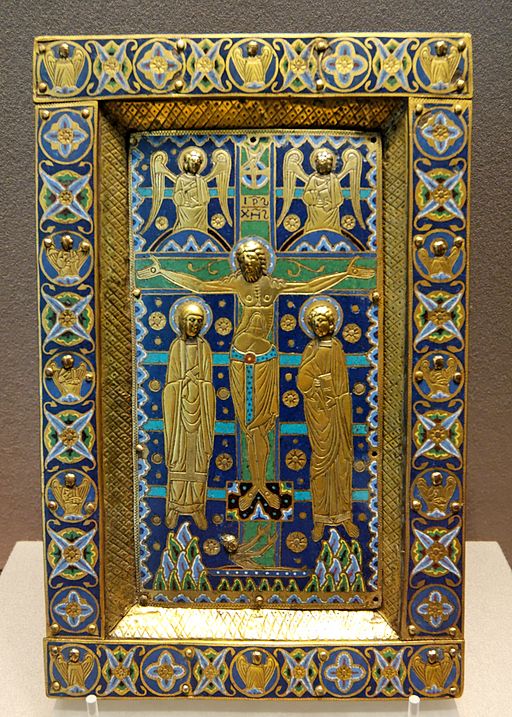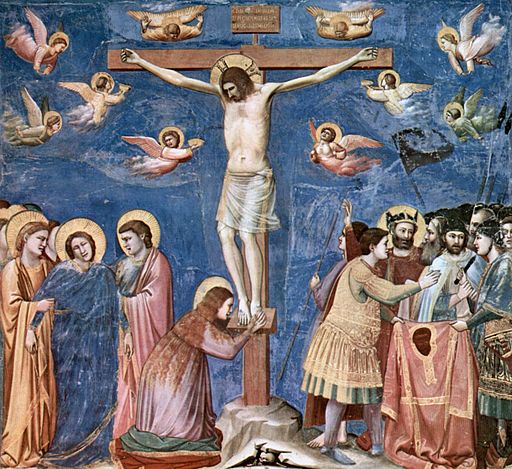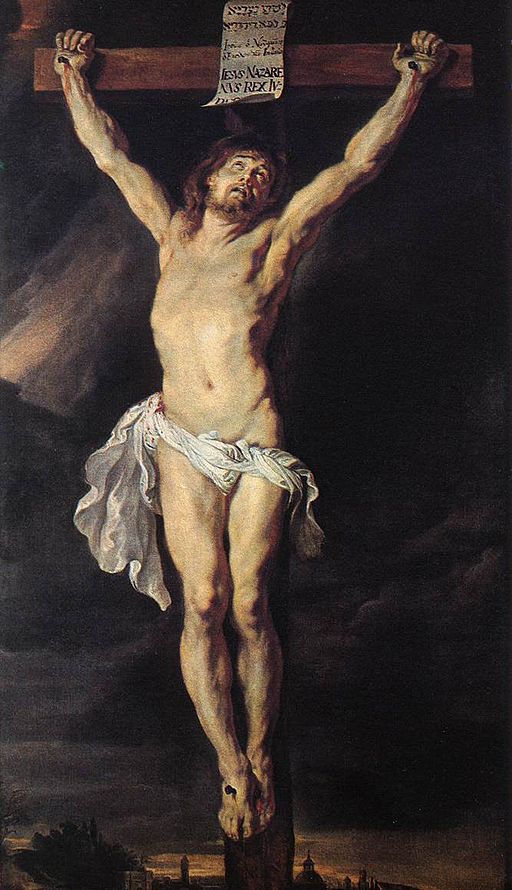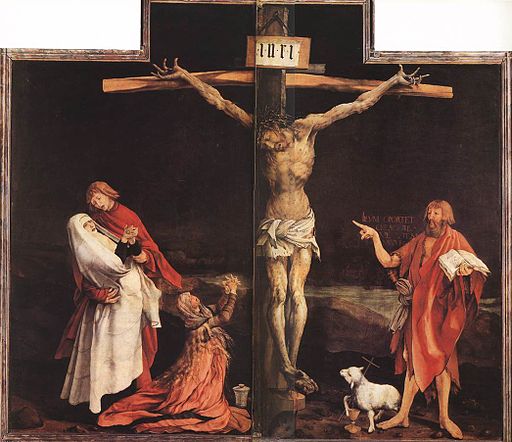Whenever I teach the Introduction to the Visual Arts (or Art History 101), I always begin by making one point very clear: art does not exist in a vacuum.
We can always learn something about the artist or the culture that produced the work of art simply by looking at it and thinking about what we see.
To make this point, I talk about one subject in art that artists have represented continuously for centuries to show how it changed over time. Today, as many people observe Good Friday, I will examine several representations of the Crucifixion. The story of the moment when Jesus died on the cross is written in the Scriptures and has not changed in centuries; however, the representation of the Crucifixion has changed dramatically over the years.
Here are some examples:
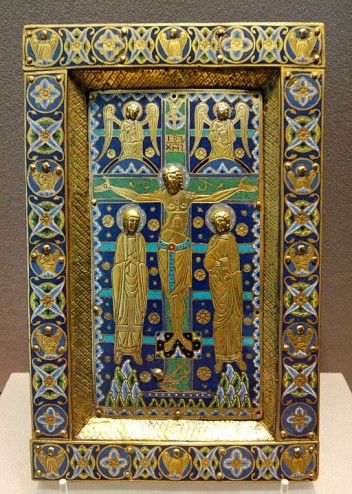
Artist Unknown, Crucifixion, c. 1200, Limoges, enamel on gilded copper, Musée du Louvre, Paris, Photo by Marie-Lan Nguyen, Public Domain via Wikimedia Commons.
This is a book cover probably for the Gospels and most likely a wealthy patron like the king of France or a bishop commissioned the work of art. The Virgin Mary and St. John the Evangelist stand on either side of the cross, as it states in the Scriptures. All three float in a heavenly realm and none of them look especially human. Jesus is divine and powerful, standing upright even in death. During the Gothic era, the church was the supreme authority and this golden depiction of the death of Jesus serves to emphasize that point.
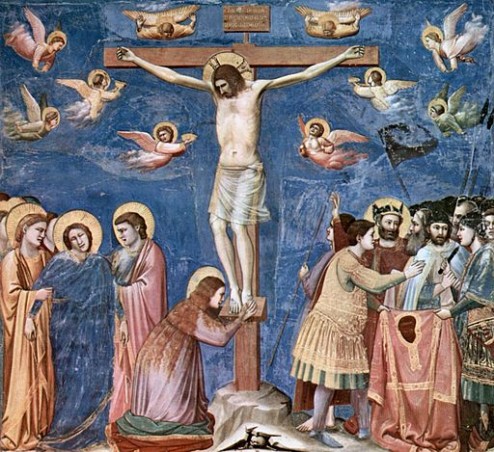
Giotto di Bondone, Crucifixion, 1305-6, fresco, Arena Chapel, Padua, Public Domain via Wikimedia Commons.
By contrast, Giotto’s Crucifixion is quite emotional. The Virgin Mary swoons at the left and is supported by John the Evangelist and one of the three Marys. Mary Magdalene cries at the feet of Jesus. Most strikingly, the angels in the sky swirl in anguish. Two carry bowls to catch the blood of Jesus as another tears its clothing off, clearly tormented by the death of Jesus.
Giotto painted this when St. Francis of Assisi and his teachings about empathetic devotion were popular in Italy, which is the reason for the focus on emotion here. St. Francis was the monk who so empathized with the suffering of Jesus that he received the stigmata, or the actual wounds of Jesus on his hands and feet.
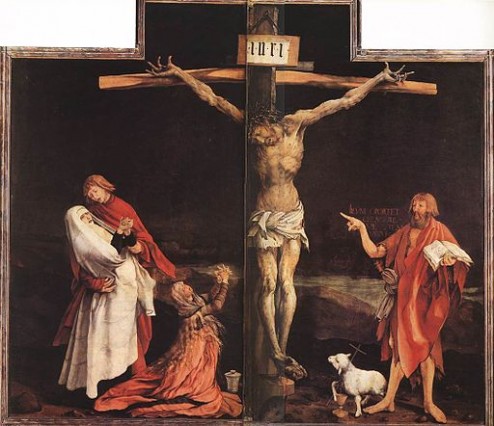
Matthias Grünewald, detail, The Isenheim Altarpiece, 1515, oil on panel, 9’9” x 10’10″, Musée d’Unterlinden, Colmar, Public Domain via Wikimedia Commons.
A couple of centuries later, the tone is still somber, but there is an emphasis on physical suffering in Matthias Grünewald’s Crucifixion. We do see emotional pain in the details, for example where Mary Magdalene’s entire body quivers with the vibrations of her wailing. Grünewald also exaggerated the length of the arm of John the Evangelist to accentuate the “heaviness” of the Virgin Mary’s emotions and the burden he has to care for her. Her skin is ghostly white because many believed that she suffered an emotional death at the time her son died.
There also is physical suffering in Grünewald’s Crucifixion. Jesus’s hands and feet twist and tear around the nails that impale him to the cross. His skin has a green cast and is pricked with blood. This German artist painted the altarpiece for a hospital where monks treated people who suffered from St. Anthony’s Fire, which was a deadly disease people contracted from fungus that grew on the rye that they ate. The artist probably emphasized the physical suffering so that the clergy and the patients could identify with the suffering of Jesus.
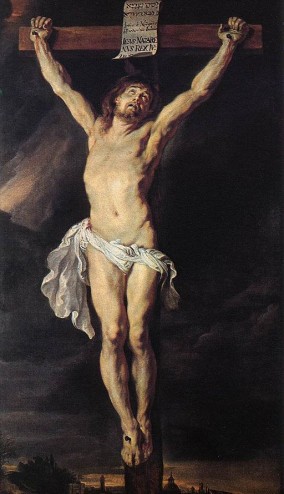
- Peter Paul Rubens, Crucifixion, 1610, oil on canvas, 86.2” x 48”, Royal Museum of Fine Arts, Antwerp, Public Domain via Wikimedia Commons.
After the Protestant Reformation, the Catholic Church met in Trento Italy to solidify church doctrine and come up with a plan to fight against the Reformation, which they did with the Counter-Reformation. The church leaders decided that art would play a role and they charged artists with creating art that was informative and that would attract people back to the Catholic Church.
Rubens was one of the finest Counter-Reformation artist in Europe, and this painting shows how well we was able to incorporate the mission of the church in his art. Ruben’s crucified Jesus is not suffering terribly. He’s not dead; he is heroic. His upright body is muscular and vital as he looms above a viewer. The emphasis here is on Jesus as the heroic Savior.
In the twentieth century, art became more about artists’ points of view – their opinions, values, fantasies, and subconscious – rather than the interests of the patron. Nevertheless, art still betrays cultural influence.
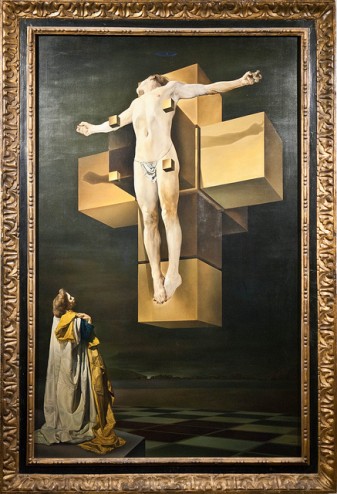
- Salvador Dalí, Crucifixion, 1954, oil on canvas, 76 ½” x 48 ¾”, Metropolitan Museum of Art, New York, Photo by gtrwndr87, Flickr, Creative Commons Attribution License.
This Crucifixion is a self-portrait. Dalí painted himself floating in air as if he were Christ on a cross that has become floating blocks. At his feet is his wife, Gala, in the role of the Virgin Mary, which is an interesting twist from someone who claimed to suffer from an Oedipus Complex.
Dalí and many other Surrealists were influenced by Sigmund Freud’s writings on psychoanalysis and the idea that humans have a subconscious that contains real, primal desires. The idea that there is another reality just beneath the surface had a profound impact on artists in the first half of the twentieth century and inspired the Cubist, Surrealist, and Abstract Expressionist art movement, to name only a few.
 Artist Unknown, Crucifixion, c. 1200, Limoges, enamel on gilded copper, Musée du Louvre, Paris, Photo by Marie-Lan Nguyen, Public Domain via Wikimedia Commons.
Artist Unknown, Crucifixion, c. 1200, Limoges, enamel on gilded copper, Musée du Louvre, Paris, Photo by Marie-Lan Nguyen, Public Domain via Wikimedia Commons.
 Giotto di Bondone, Crucifixion, 1305-6, fresco, Arena Chapel, Padua, Public Domain via Wikimedia Commons.
Giotto di Bondone, Crucifixion, 1305-6, fresco, Arena Chapel, Padua, Public Domain via Wikimedia Commons.
 Matthias Grünewald, detail, The Isenheim Altarpiece, 1515, oil on panel, 9’9” x 10’10″, Musée d’Unterlinden, Colmar, Public Domain via Wikimedia Commons.
Matthias Grünewald, detail, The Isenheim Altarpiece, 1515, oil on panel, 9’9” x 10’10″, Musée d’Unterlinden, Colmar, Public Domain via Wikimedia Commons.



